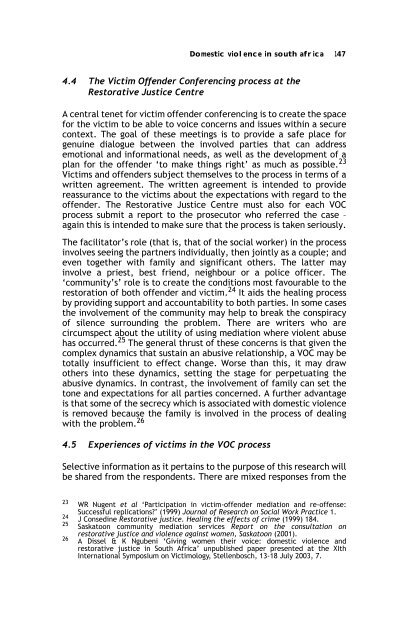Sex, Gender, Becoming - PULP
Sex, Gender, Becoming - PULP
Sex, Gender, Becoming - PULP
You also want an ePaper? Increase the reach of your titles
YUMPU automatically turns print PDFs into web optimized ePapers that Google loves.
Domestic violence in south africa 147<br />
4.4 The Victim Offender Conferencing process at the<br />
Restorative Justice Centre<br />
A central tenet for victim offender conferencing is to create the space<br />
for the victim to be able to voice concerns and issues within a secure<br />
context. The goal of these meetings is to provide a safe place for<br />
genuine dialogue between the involved parties that can address<br />
emotional and informational needs, as well as the development of a<br />
plan for the offender ‘to make things right’ as much as possible. 23<br />
Victims and offenders subject themselves to the process in terms of a<br />
written agreement. The written agreement is intended to provide<br />
reassurance to the victims about the expectations with regard to the<br />
offender. The Restorative Justice Centre must also for each VOC<br />
process submit a report to the prosecutor who referred the case –<br />
again this is intended to make sure that the process is taken seriously.<br />
The facilitator’s role (that is, that of the social worker) in the process<br />
involves seeing the partners individually, then jointly as a couple; and<br />
even together with family and significant others. The latter may<br />
involve a priest, best friend, neighbour or a police officer. The<br />
‘community’s’ role is to create the conditions most favourable to the<br />
restoration of both offender and victim. 24 It aids the healing process<br />
by providing support and accountability to both parties. In some cases<br />
the involvement of the community may help to break the conspiracy<br />
of silence surrounding the problem. There are writers who are<br />
circumspect about the utility of using mediation where violent abuse<br />
has occurred. 25 The general thrust of these concerns is that given the<br />
complex dynamics that sustain an abusive relationship, a VOC may be<br />
totally insufficient to effect change. Worse than this, it may draw<br />
others into these dynamics, setting the stage for perpetuating the<br />
abusive dynamics. In contrast, the involvement of family can set the<br />
tone and expectations for all parties concerned. A further advantage<br />
is that some of the secrecy which is associated with domestic violence<br />
is removed because the family is involved in the process of dealing<br />
with the problem. 26<br />
4.5 Experiences of victims in the VOC process<br />
Selective information as it pertains to the purpose of this research will<br />
be shared from the respondents. There are mixed responses from the<br />
23<br />
WR Nugent et al ‘Participation in victim-offender mediation and re-offense:<br />
Successful replications?’ (1999) Journal of Research on Social Work Practice 1.<br />
24 J Consedine Restorative justice. Healing the effects of crime (1999) 184.<br />
25<br />
Saskatoon community mediation services Report on the consultation on<br />
restorative justice and violence against women, Saskatoon (2001).<br />
26 A Dissel & K Ngubeni ‘Giving women their voice: domestic violence and<br />
restorative justice in South Africa’ unpublished paper presented at the XIth<br />
International Symposium on Victimology, Stellenbosch, 13-18 July 2003, 7.
















